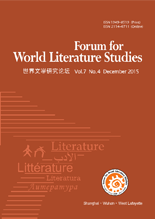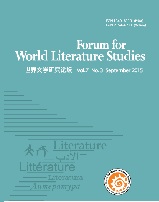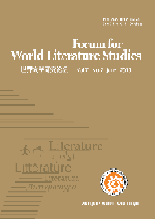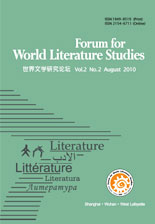Politics, History and Aesthetics as Tropes: An Introduction
The studies of trope and literature have been closely connected on both theoretical
and textual levels ever since antiquity, and many great literary works were written
by writers who were well versed in tropes. It is therefore worthwhile to examine
thoroughly what these writers know about tropes and how literary creationand
literary criticism have been enriched through rhetorical knowledge. As early as 16th
century, Richard Sherry has already come to the realization of the relations between
trope and literature. In his ground breaking monograph A Treatise of Schemes and
Tropes(1550), Richard suggests that trope is the tool for “achieving ornateness”
in both secular and religious writing and speaking(Hildebrandt2). In this mode of
thought, the tropes like metaphor, metonymy and synecdocheare basic human tools
of understanding, and they are both mentally and physically anchored in literature.
The meaning of trope goes through a long process of transformation from
figure of speech to discourse. From the perspective of rhetorical tradition, the value
of trope to literature lies in its feature of deviation (Harland4). In standard rhetorical
terminology, a trope is a deviation from the normal use of an individual word;
But with the development of literary criticism, trope is endowed with broader and
more complicated meanings. Recently many literary debates hinge on competing
definitions of “trope” between motif and rhetorical turn(Dvora&New), leading
to rhetorical studies of politics, economics, space, history and aesthetics across
cultural divides in literary works. Therefore in order to understand these exchanges
between literature and other various dimensions of the world, it is productive to
take different tropes into consideration in our critical readings and writings.
The three essays presented below address the aforementioned relations
between trope and literature in very different ways. They are diverse in terms of
themes, subjects and theoretical approaches, which, at first glance, bear no relation
to one another.Anne-Marie Mai, professor of Nordic Literature at the University
of Southern Denmark and a Fellow of the Danish Academy of Arts and Sciences,
begins this special cluster of articles with her study of welfare metaphors and
welfare critique in works by Danish writers Kirsten Thorup, Vibeke Grønfeldt and
Jette Drewsen. Shelooks closely at how these Danish novelists’ works interact with
the development of the Danish welfare state. The second contribution to this special
cluster comes from Agnieszka Łobodziec, of the University of Zielona Gora in
Poland. She focuses on Toni Morrison’s novel A Mercy, examining how Morrison
elucidates the emotional dynamics between white subjects and black objects and
their individual feelings at the genesis of racial and social bifurcation of mainstream
American society that subsequently evolved into systemic racialized slavery.
Another contribution to this cluster comes from Jørgen Veisland, of the University
of Gdansk in Poland. He explores the issue of the aesthetics of loss in American
writer Paul Auster’s Sunset Park.Based on Kristeva’s analysis of abjection, Jørgen
Veisland examines how Paul Auster combines realism and abstract form in an
attempt to capture pure thingness and the in-betweenness of things.
Although the three articles are varied in many ways, however, on a deeper
level, they do have one thing in common. The tropes of politics, history and
aesthetics are the unifying metaphors among the three essays and trope as the
key word runs through the three essays. In Anne-Marie Mai’s essay, welfare is a
metaphor which, as a “dreamwork of language,” establishes a metaphorical house
to accommodate rich political and social meanings(Davison 435). Mai holds that
the house metaphor is not substantial, but it forms a clear metonymic basis in the
imagery used, and it has a reference back to the biblical metaphoric of the house
and the temple building that was used in the labour movement songs from the end
of the 19th century, where for example Ulrich Peter Overbuy made use of biblical
expression when writing about the new society as “a strong house we build to
protect us in need.”In terms of cognitive pattern, house is a spatial pattern and
a part-whole pattern which can be used in the study of the deep framing of the
welfare state and its objectives.
Mai’s house metaphor explores the abstract welfare issue in two different
ways. First of all, to concretize and visualise the abstract object. The metaphor
is the “main mechanism” through which we comprehend abstract concepts and
perform abstract reasoning. Therefore the idea of the welfare state becomes “spatial
and concrete” when it is visualises as a home for the people and a societal family to
the public. Secondly,to fill in the gap between writer and reader. The productivity
of metaphor results from the fact that the interpretations of metaphor reflects as
much on the interpreter as on the originator. So to understand a metaphor is as
much a creative endeavour as to make a metaphor (Davidson 435). Based on this
cognitive feature of metaphor, Anne-Marie Mai sets up a bridge across the readers
and writers, through which the linguistic framing of the welfare state and its
metaphorical patterns created by the writers are transmitted to the readers and are
transformed to a social and political sphere of experience of the readers.
In Agnieszka Łobodziec’s essay, Toni Morrison’s emotional trope in A Mercy
is viewed as a literary representation of historical truth. It is interesting to note
that Agnieszka Łobodziec starts her analysis from “the etiology of the American
Dream.” To women, and especially to black women in the U.S., the realization
of American Dream is a process of “Housing” or “Unhousing” the “gendered
self”(Kalfopoulou1). In some sense, Agnieszka Łobodziec continues and extends
the house metaphor initated by Mai in her article, but Łobodziec’s house metaphor
targets to a completely different point. To African American woman writer in the
U.S., their American dream is a struggling out of the father’s house, the slavery
house and the interiorized slaverized house. And therefore their fulfillment of self is
a process of “coming home”(Kalfopoulou173).
However Agnieszka Łobodziec’s American dream metaphor and interiorized
metaphor are only parts of the story. It is obvious that Agnieszka Łobodziec is
taking good use of the concept that the balck tradition is double-voiced utterance,
or as Henry Louis Gates, Jr. put, possesses “two mouths” (341). This spirit of the
double-voiced utterance is in the same vein with the nature of metaphor in which
a word or phrase denoting one kind of object or idea is used in place of another
in order to suggest similarity or difference between them. Via these two mouths,
Agnieszka Łobodziechopes to enhance the reader’s experience of black texts by
identifying levels of meaning and expression that might otherwise remain buried
beneath the surface.
Jørgen Veisland explores Paul Auster’sexperiment in trying to dissolve and
then reconstruct the relation between thing and sign, res and signum in Sunset
Park. It is obvious that Jørgen Veisland adopts a Lacanian perspective. German
scholar Heiko Jakubzik in his dissertation proposes that there are two central
influences in Paul Auster’s writing, one is Jacques Lacan’s psychoanalysis and the
other the American transcendentalism of the early to middle nineteenth century.
This Lacanian psychoanalytical approach to the relations between world and
language, between thing and sign is metaphorical in the sense that Lacan’s key
concept symptom is first described as a metaphor, then as an ego: the subject
of literature, the writing and written subject will ultimately become a myth for
culture(Rabate19). Auster’s text reverses the history of semiotics in trying to
capture existence prior to the sign, which in some sense explains the reason why
we need a metaphor. The sense of being outside language, and thus outside of the
world is exactly the reason why we need a metaphor, and why we need art. Just as
Jørgen Veisland put in his analysis that access to “the world of others” is “through
the work of art only.” It is perhaps not an exaggeration to say that Jørgen Veisland’s
study in some sense provides a theoretical framework for the other two articles in
terms of linguistics, psychology and language philosophy, or in other words, it is an
aesthetic trope for the other two essays in this special cluster.
It is somewhat surprising how differently and extensively tropes play the
roles in literary expression. The three critics identify politics, history and aesthetic
as epistemological tropes that offerdifferent and effective ways to rethink identity,
otherness, society and art. In other words, politics, society and aesthetics are
exciting and useful tropes for the epistemological shift from reading the word to
reading the world so as to detect the truth deep beneath the surface.
Works Cited
Davidson, Donald. “What Metaphors Mean.” The Philosophy of Language.Fourth Edition. Ed. A.
P. Martinich. New York, Oxford: Oxford University Press, 2001. 435-446.
Dvorak,Marta&W. H. New,eds.Tropes and Territories: Short Fiction, Postcolonial Readings,
Canadian Writings in Context. London: McGill-Queen’s University Press, 2007.
Gates,Henry Louis, Jr.“Introduction to The Signifying Monkey.”African American Literary
Theory: A Reader. Ed. Winston Napier. New York and London: New York University Press,
2000.339-347.
Harland,Richard.Literary Theory from Plato to Barthes: An Introductory History. Beijing:
Foreign Language Teaching and Research Press, 2005.
Hildebrandt,Herbert W. “Introduction.”A Treatise of Schemes and Tropes. Gainesville: Scholar’s
Facsimiles & Reprints, 1961.2-16.
Kalfopoulou, Adrianne. A Discussion of the Ideology of the American Dream in the Culture’s
Female Discourses: The Untidy House. Lewiston, Queenston, Lampeter:The Edwin Mellen
Press,2000.
Lakoff, Georg& Mark Johnson. Metaphors We Live By. Chicago: The University of Chicago
Press,1980.
Rabate,Jean-Michel Jacques.JacquesLacan: Psychoanalysis and the Subject of Literature.New
York: PalgraveMacmillan,2001.
and textual levels ever since antiquity, and many great literary works were written
by writers who were well versed in tropes. It is therefore worthwhile to examine
thoroughly what these writers know about tropes and how literary creationand
literary criticism have been enriched through rhetorical knowledge. As early as 16th
century, Richard Sherry has already come to the realization of the relations between
trope and literature. In his ground breaking monograph A Treatise of Schemes and
Tropes(1550), Richard suggests that trope is the tool for “achieving ornateness”
in both secular and religious writing and speaking(Hildebrandt2). In this mode of
thought, the tropes like metaphor, metonymy and synecdocheare basic human tools
of understanding, and they are both mentally and physically anchored in literature.
The meaning of trope goes through a long process of transformation from
figure of speech to discourse. From the perspective of rhetorical tradition, the value
of trope to literature lies in its feature of deviation (Harland4). In standard rhetorical
terminology, a trope is a deviation from the normal use of an individual word;
But with the development of literary criticism, trope is endowed with broader and
more complicated meanings. Recently many literary debates hinge on competing
definitions of “trope” between motif and rhetorical turn(Dvora&New), leading
to rhetorical studies of politics, economics, space, history and aesthetics across
cultural divides in literary works. Therefore in order to understand these exchanges
between literature and other various dimensions of the world, it is productive to
take different tropes into consideration in our critical readings and writings.
The three essays presented below address the aforementioned relations
between trope and literature in very different ways. They are diverse in terms of
themes, subjects and theoretical approaches, which, at first glance, bear no relation
to one another.Anne-Marie Mai, professor of Nordic Literature at the University
of Southern Denmark and a Fellow of the Danish Academy of Arts and Sciences,
begins this special cluster of articles with her study of welfare metaphors and
welfare critique in works by Danish writers Kirsten Thorup, Vibeke Grønfeldt and
Jette Drewsen. Shelooks closely at how these Danish novelists’ works interact with
the development of the Danish welfare state. The second contribution to this special
cluster comes from Agnieszka Łobodziec, of the University of Zielona Gora in
Poland. She focuses on Toni Morrison’s novel A Mercy, examining how Morrison
elucidates the emotional dynamics between white subjects and black objects and
their individual feelings at the genesis of racial and social bifurcation of mainstream
American society that subsequently evolved into systemic racialized slavery.
Another contribution to this cluster comes from Jørgen Veisland, of the University
of Gdansk in Poland. He explores the issue of the aesthetics of loss in American
writer Paul Auster’s Sunset Park.Based on Kristeva’s analysis of abjection, Jørgen
Veisland examines how Paul Auster combines realism and abstract form in an
attempt to capture pure thingness and the in-betweenness of things.
Although the three articles are varied in many ways, however, on a deeper
level, they do have one thing in common. The tropes of politics, history and
aesthetics are the unifying metaphors among the three essays and trope as the
key word runs through the three essays. In Anne-Marie Mai’s essay, welfare is a
metaphor which, as a “dreamwork of language,” establishes a metaphorical house
to accommodate rich political and social meanings(Davison 435). Mai holds that
the house metaphor is not substantial, but it forms a clear metonymic basis in the
imagery used, and it has a reference back to the biblical metaphoric of the house
and the temple building that was used in the labour movement songs from the end
of the 19th century, where for example Ulrich Peter Overbuy made use of biblical
expression when writing about the new society as “a strong house we build to
protect us in need.”In terms of cognitive pattern, house is a spatial pattern and
a part-whole pattern which can be used in the study of the deep framing of the
welfare state and its objectives.
Mai’s house metaphor explores the abstract welfare issue in two different
ways. First of all, to concretize and visualise the abstract object. The metaphor
is the “main mechanism” through which we comprehend abstract concepts and
perform abstract reasoning. Therefore the idea of the welfare state becomes “spatial
and concrete” when it is visualises as a home for the people and a societal family to
the public. Secondly,to fill in the gap between writer and reader. The productivity
of metaphor results from the fact that the interpretations of metaphor reflects as
much on the interpreter as on the originator. So to understand a metaphor is as
much a creative endeavour as to make a metaphor (Davidson 435). Based on this
cognitive feature of metaphor, Anne-Marie Mai sets up a bridge across the readers
and writers, through which the linguistic framing of the welfare state and its
metaphorical patterns created by the writers are transmitted to the readers and are
transformed to a social and political sphere of experience of the readers.
In Agnieszka Łobodziec’s essay, Toni Morrison’s emotional trope in A Mercy
is viewed as a literary representation of historical truth. It is interesting to note
that Agnieszka Łobodziec starts her analysis from “the etiology of the American
Dream.” To women, and especially to black women in the U.S., the realization
of American Dream is a process of “Housing” or “Unhousing” the “gendered
self”(Kalfopoulou1). In some sense, Agnieszka Łobodziec continues and extends
the house metaphor initated by Mai in her article, but Łobodziec’s house metaphor
targets to a completely different point. To African American woman writer in the
U.S., their American dream is a struggling out of the father’s house, the slavery
house and the interiorized slaverized house. And therefore their fulfillment of self is
a process of “coming home”(Kalfopoulou173).
However Agnieszka Łobodziec’s American dream metaphor and interiorized
metaphor are only parts of the story. It is obvious that Agnieszka Łobodziec is
taking good use of the concept that the balck tradition is double-voiced utterance,
or as Henry Louis Gates, Jr. put, possesses “two mouths” (341). This spirit of the
double-voiced utterance is in the same vein with the nature of metaphor in which
a word or phrase denoting one kind of object or idea is used in place of another
in order to suggest similarity or difference between them. Via these two mouths,
Agnieszka Łobodziechopes to enhance the reader’s experience of black texts by
identifying levels of meaning and expression that might otherwise remain buried
beneath the surface.
Jørgen Veisland explores Paul Auster’sexperiment in trying to dissolve and
then reconstruct the relation between thing and sign, res and signum in Sunset
Park. It is obvious that Jørgen Veisland adopts a Lacanian perspective. German
scholar Heiko Jakubzik in his dissertation proposes that there are two central
influences in Paul Auster’s writing, one is Jacques Lacan’s psychoanalysis and the
other the American transcendentalism of the early to middle nineteenth century.
This Lacanian psychoanalytical approach to the relations between world and
language, between thing and sign is metaphorical in the sense that Lacan’s key
concept symptom is first described as a metaphor, then as an ego: the subject
of literature, the writing and written subject will ultimately become a myth for
culture(Rabate19). Auster’s text reverses the history of semiotics in trying to
capture existence prior to the sign, which in some sense explains the reason why
we need a metaphor. The sense of being outside language, and thus outside of the
world is exactly the reason why we need a metaphor, and why we need art. Just as
Jørgen Veisland put in his analysis that access to “the world of others” is “through
the work of art only.” It is perhaps not an exaggeration to say that Jørgen Veisland’s
study in some sense provides a theoretical framework for the other two articles in
terms of linguistics, psychology and language philosophy, or in other words, it is an
aesthetic trope for the other two essays in this special cluster.
It is somewhat surprising how differently and extensively tropes play the
roles in literary expression. The three critics identify politics, history and aesthetic
as epistemological tropes that offerdifferent and effective ways to rethink identity,
otherness, society and art. In other words, politics, society and aesthetics are
exciting and useful tropes for the epistemological shift from reading the word to
reading the world so as to detect the truth deep beneath the surface.
Works Cited
Davidson, Donald. “What Metaphors Mean.” The Philosophy of Language.Fourth Edition. Ed. A.
P. Martinich. New York, Oxford: Oxford University Press, 2001. 435-446.
Dvorak,Marta&W. H. New,eds.Tropes and Territories: Short Fiction, Postcolonial Readings,
Canadian Writings in Context. London: McGill-Queen’s University Press, 2007.
Gates,Henry Louis, Jr.“Introduction to The Signifying Monkey.”African American Literary
Theory: A Reader. Ed. Winston Napier. New York and London: New York University Press,
2000.339-347.
Harland,Richard.Literary Theory from Plato to Barthes: An Introductory History. Beijing:
Foreign Language Teaching and Research Press, 2005.
Hildebrandt,Herbert W. “Introduction.”A Treatise of Schemes and Tropes. Gainesville: Scholar’s
Facsimiles & Reprints, 1961.2-16.
Kalfopoulou, Adrianne. A Discussion of the Ideology of the American Dream in the Culture’s
Female Discourses: The Untidy House. Lewiston, Queenston, Lampeter:The Edwin Mellen
Press,2000.
Lakoff, Georg& Mark Johnson. Metaphors We Live By. Chicago: The University of Chicago
Press,1980.
Rabate,Jean-Michel Jacques.JacquesLacan: Psychoanalysis and the Subject of Literature.New
York: PalgraveMacmillan,2001.







